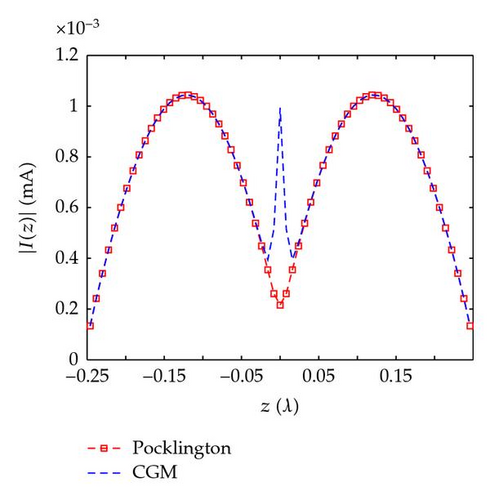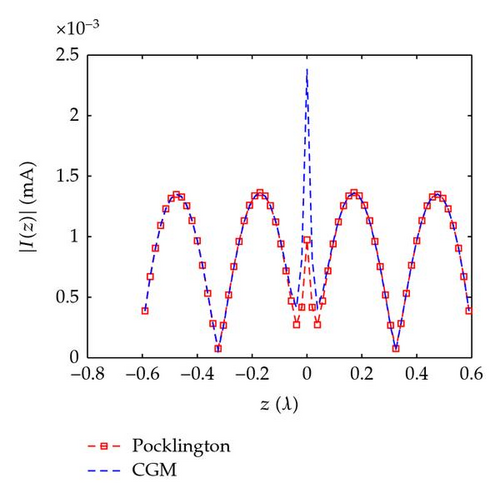A Comparison of Two Methods for Solving Electromagnetic Field Integral Equation
Abstract
The present paper aims to compare Harrington′s direct method of moment (MoM) with the conjugate gradient method (CGM) by evaluating the total current solving the electric field integral equation (EFIE). Based on their performances, the number of iterations needed for convergence, storage, and the level of precision, it is found that the direct MoM is more efficient than other iterative CGM.
1. Introduction
In this paper, we consider the integral electromagnetic field equation (EFIE) for computing the total current distribution on antenna surfaces, and we study the two standard methods by comparing the solutions. These methods are the direct method of moment (MoM for short) developed by Harrington [1] and the iterative conjugate gradient method (CGM) [2]. This comparative study, which is done at the level of numerical solutions, is achieved in terms of computational advantages and disadvantages as well as their ability to determine the current distributions on metal surfaces. Based on their performance, the number of iterations needed for convergence, the storage, and the level of precision, it comes out from our analysis, developed in the next sections, that the direct method MoM is more efficient than other iterative CGM.
Recall that the electromagnetic field has been successfully used in the computation of the current distribution over the surface with few geometries yielding analytic solutions. To deal with the study of the above-mentioned integral electromagnetic field equation, the most popular method for getting numerical solutions is given by the method of moment with advantages and disadvantages. Regarding the disadvantages of this approach, we mention the one related to the convergence problem and the second connected with the restriction of the explicit storage of a the dense matrix. Furthermore, the monotonic convergence in the MoM solution can be achieved under only stringent condition which are difficult to realize in case of complex problems [2]. In attempt to address the above disadvantages of the direct MoM, another alternative approach has been suggested; this concerns the CGM for solving iteratively the electromagnetic problem [3, 4]. Since then, CGM has been successfully applied to a number of radiation and scattering problems and has been quite popular because of the O(N) memory requirement. Using discretization of EFIE in the framework of the MoM to get the impedance matrix Z [5], Sarkar and Rao applied to the Z matrix the CGM of steepest descent to calculate the charge distribution over conducting surfaces [6]. However, few attempts have been done to apply CGM to electrostatic problems involving conducting surfaces. The presentation of this paper is as follows: in Section 2, we give some generalities on EFIE. In Section 3, we review some useful aspects on the method of moment. In Section 4, we describe the algorithm of the CGM. In Section 5, we work out the numerical solutions of EFIE using both MoM and CGM. Last section is devoted to the conclusion.
2. Generalities on EFIE
Electromagnetic field has been successfully used in the computation of finding the current distribution over the surface. Solving current distributions on metal surface usually incorporates formulation of EFIE (electric field integral equation) [7]. Few geometries yields solutions (analytical, numerical approximation) have been successfully used. But most of the popular method is the method of moment.
3. Useful Tools on MoM
- (i)
Firstly, let the basis functions be f1, f2, …, fN. The unknown function f is expanded in terms of a linear combination of these basis functions:
(3.2)The linear combination of fn should represent the unknown f in the domain. Substitute (3.1) into (2.9), we have that, upon using the linearity of the operator L, the unknown amplitudes can be brought out of the operator giving(3.3)where α1, α2, …, αN are unknown coefficients that have to be determined. - (ii)
Secondly, we define a set of N weighting functions (testing functions), ω1, ω2, …, ωN, which are integrated with (3.3) to give m different linear equations, and take the inner product of the previous equation with ωm:
(3.4)The system can now be written in matrix form as(3.5)where(3.6)If the matrix Amn is not singular, the unknowns αn are simply given by(3.7)and the original function f can be reconstructed using (3.3). We can now generalize the following definitions.
Basis Functions Basis functions can use full domain functions such as special functions, polynomials, and so forth. A set that is useful for practical problem is the subsectional basis function. This means that each fn is only nonzero over a subsection of the domain of f. A common choice is the pulse function:
Weighting Functions (Testing Functions) Two common choices are as follow.
- (i)
Point matching: taking Dirac delt δ functions as testing functions ωm(x) = δ(x − xm) where m = 1,2, …, N.
- (ii)
Galerkin Method: if we used the same function for both the basis and weighting f, that is. If we used the same function for both fn(x) = ωn(x) where n = 1,2, …, N.
4. Conjugate Gradient Method
5. Numerical Results
The results are given through two examples concerning straight wire scatterers.
5.1. First Example
As a first example of a straight-wire scatterer, we consider the simple straight-wire scatterer of length l = 0.5λ and radius a = 0.001λ. The scatterer is excited by a plane wave with a 45° angle of incidence; this example has been taken from a well-known book [7]. Figure 1 show the computed currents (direct solution MoM) according to Pocklington equations compared with conjugate gradient method. In these figures, we present the result for the current distribution along the antenna that we obtain through our own developments using MATLAB. This comparison shows that the movement is retained with some minor differences in middle of the curve. Notice that our result (under MATLAB) agrees with the one published in [9]. Notice also that one of the essential tasks in our way of doing is the use of the moment method and the choice of test and basis functions.


5.2. Second Example
In this example we consider the scattering from the straight-wire scatterer of length l = 1.2λ and radius a = 0.001λ shown in Figure 2; the current has a delta-gap compared with the sinusoidal current I(z) = Asink(h−|z|) and with the current found by CGM.


6. Conclusion
In this paper, we have presented a comparative study of the direct method of moment and the iterative conjugate gradient method. These methods are used to solve the differential linear equations; in particular, the integral electromagnetic field equation (EFIE) for computing the total current distribution. Based on their performances, the number of iterations needed for convergence, storage, and the level of precision, we have found that the direct MoM is more efficient than other iterative CGM.
Acknowledgments
The author would like to thank professor E. H Saidi for helpful discussions and URAC 09 for support.




